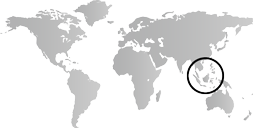Mainland Southeast Asia
Over the course of the nineteenth century, Southeast Asia is colonized by Britain, France, and Holland. In 1799, the Dutch government takes over the Dutch East India Company’s rule of parts of the Indonesian archipelago. Over the next hundred years, it extends control throughout the entire archipelago, including Sumatra and Bali. The modern boundaries of Indonesia are established at this time. Starting in 1824, Britain fights for control of Burma, finally incorporating it into its Indian empire in 1886. It gradually takes over peninsular Malaya as well, and by 1874 effectively rules the area that will become modern-day Malaysia. By strengthening central authority over local chiefs and opening trade to Europe, Thailand remains free under a stable and strong monarchy. But France colonizes Vietnam, Laos, and Cambodia to proclaim the French Indochina Union in 1887.
Colonization has an enormous impact on the populations and economies of the region. The British favor Indian and Chinese immigrants for skilled positions in Malaysia, and dismiss the general Malaysian population as peasantry. Education policies deepen ethnic divides. In Cambodia, the French favor the Vietnamese over the local population, while the British encourage widespread immigration of Indians and Chinese into Burma, a policy that leads to political division felt into contemporary times. The Burmese economy, long based on subsistence farming, shifts drastically to a large-scale export economy. A policy called Cultuurstelsel, applied in Indonesia, forces farmers to grow export crops. Though successful in some ways, the policy causes famine and impoverishment. The desire to sell European goods in colonial markets erodes traditional crafts, such as the production of batik and ikat textiles in Indonesia. Regular wars waged to gain control further damage the region.
Under colonial domination, however, ancient monuments and texts are closely studied, preserved, and restored. Angkor Wat, for instance, is rediscovered in the mid-nineteenth century, and the monuments of Cham, in Vietnam, come to public attention in 1885. Photography aids in the documentation of these monuments: Angkor Wat is photographed for the first time in 1866. From the mid-nineteenth century onward, colonial governments begin to open museums and found archaeological surveys. While knowledge of the past is gathered in the service of power, it also generates respect for and pride in Southeast Asian cultures, and becomes an important source of inspiration for local artists in the twentieth century who strive to create modern, non-Western arts.
Many traditions continue to thrive in the nineteenth century. Religious imagery tends to be conservative and relatively immune to Westernization. Many indigenous courts patronize a high level of craftsmanship in textiles, metalwork, jewelry, and ceramics. Manuscript paintings remain largely traditional, though some reveal European influences and resemble the Company School paintings of India. During the early nineteenth century, China is a dominant cultural influence in mainland Southeast Asia. However, elite culture becomes increasingly Westernized as colonial powers expand their control. In Burma, for instance, European pictorial conventions dominate the frescoes at the Kyauk-Taw-Gyi Temple (1849–50), while the Altumashi Monastery in Mandalay (1857) mixes European and indigenous architectural structures and motifs. The Javanese painter Raden Saleh (ca. 1807–1880), considered the “father” of Indonesian modern art, travels to Europe to study painting in 1829. Western art makes an impression much later in Vietnam, beginning with a few painters like Le Van Mien (1873–1943), who work in oils in the late nineteenth century. Despite Thailand’s independence, the passion for things Western hits the elite at this time as well. The architecture of King Mongkut (r. 1851–68) incorporates Greek orders and Chinese ceramics into a Thai stylistic rubric. Over the next half century and well into the early twentieth, photography and naturalistic painting and sculpture dominate Thai court art.
Island Southeast Asia
While the great majority of the population in this period are Muslim, Buddhist, or Christian, Southeast Asia is also home to a diversity of indigenous peoples who share aspects of their language, art, and culture with the Polynesians, Micronesians, and other Pacific Island groups. Often living in isolated enclaves separated by hundreds, even thousands, of miles, the region’s indigenous peoples nonetheless exhibit remarkable similarities in their art and cultures, indicating that these groups share a common ancestry. One of the most striking similarities is in their conception of the human form, which is typically depicted in a seated or crouching position with the legs drawn close to the body and the hands or forearms resting on the knees.
Sculpture in indigenous Southeast Asian societies serves as a means of honoring and communicating with the supernatural beings believed to ensure the safety and prosperity of the village community. Most images depict local ancestors or fearsome supernatural guardians. Southeast Asia’s indigenous peoples, particularly in Indonesia, also create a rich variety of textiles. However, by the mid-nineteenth century, the colonial powers begin to send Christian missionaries to convert indigenous peoples from their local religions, and many artistic traditions, particularly the creation of figural sculpture, begin to decline.


